Since its release on June 20, 1975, JAWS has become an unstoppable force in the realm of shark pop culture. The original film stayed on screens for over a year, and its first sequel, released in 1978, was the highest-grossing sequel ever made until THE EMPIRE STRIKES BACK came along two years later. When the first film debuted on television in the fall of 1979, it received a 39.1 share, showing that over 50 million Americans tuned into a film that had already been on the silver screen for more than four years. JAWS was, in the ‘70s and into the early ‘80s, as big of a juggernaut as the maneater it depicted.
Similarly, the era heralded the explosion of video games. Nolan Bushnell’s PONG had launched in 1972, and quarter-sucking pixel players soon lined the halls of bars, bowling alleys and arcades across the nation. Video games were as much a part of American culture as JAWS was, if not even more so.
It’s odd, then, that the first authorized video game based on the JAWS franchise didn’t occur until 1987, when JAWS (the game) emerged on the Nintendo Entertainment System. By this time, JAWS-mania had subsided (while released the same year as the notorious flop JAWS: THE REVENGE, the game is unrelated) and Universal Pictures had completely missed their chance at maximizing the impact of a digital version of the shark-hunting classic.
So what the heck happened? How did the potential for Amity Island-related gameplay completely miss the Atari age?
It wasn’t for lack of trying.
 Photograph or scan is copyright of Krister Nielsen. All objects depicted in this image are copyright of their respective owners.
Photograph or scan is copyright of Krister Nielsen. All objects depicted in this image are copyright of their respective owners.
Part of the issue is that movie licensing for video games just wasn’t done at the time of the original film’s release. It’s generally agreed upon that TRON: DEADLY DISCS, released in 1982 for the Intellivision, was the first video game based on a film license – not too shocking, as TRON’s plot made it a natural for adapting to the arcade. In this case, TRON: DEADLY DISCS actually beat the movie itself to release[ by six months – the film’s release itself was coupled with the arcade games TRON and DISCS OF TRON, the Intellivision follow-up TRON: MAZE-A-TRON, and the Atari 2600 release ADVENTURES OF TRON. (The first video game based on any sort of licensed character may be 1976’s Fonz, a motorcycle racing game from Sega where you control the coolest man alive. It is unclear if any sharks are jumped.)
The success of the Tron games would soon lead to the likes of RAIDERS OF THE LOST ARK, KRULL, WARGAMES, a horde of releases from 20th Century Fox including the never-released Planet of the Apes, and, of course, the infamous E.T. THE EXTRA TERRESTRIAL. The world of movie licensing to video games would never be the same.
(“But wait!” you inject knowingly, having found something to correct on the internet. “What about DEATH RACE, the controversial video game from 1976 based on Paul Bartel’s classic film DEATH RACE 2000?” Well, wise guy, Exidy’s DEATH RACE, despite having a similar concept to the similarly-titled film in that you’re in a car running over things, it’s not based on it. Also, that’s a completely different article. Watch Daily Grindhouse for that story soon.)
The concept of doing a video game tie-in having not yet really materialized, the concept of melting sharks and joysticks was fair game. As a result, there would be more than a half-dozen video games within the next few years that would, no doubt, have never existed if it weren’t for JAWS. Arcade-goers may have not been able to play a recreation of Quint, Brody and Hooper tracking down their bloodthirsty prey, but thanks to a few enterprising video game programmers, they could find suitable substitutes.
KILLER SHARK (Sega, 1972)
Our first entry into the Jawsploitation canon actually predates JAWS by a couple of years, and isn’t actually a video game! So why is it included? Well, Sega’s KILLER SHARK has a special place in history, in that it actually appears in JAWS itself, being played at an Amity arcade.
While housed in a cabinet with a design similar to any video game fan (complete with a gun), KILLER SHARK utilized a series of slides containing photos of sharks on a wheel as a display similar to an old zoetrope rather than a monitor. The player would use the spear gun at his disposal and shoot the shark to earn points and cause the image to switch to a bleeding shark. A similar game, SEA DEVIL, was released by Sega the same year, but only one had the distinction of appearing in a Hollywood blockbuster. Director Steven Spielberg reportedly spent time on the JAWS set playing PONG with Roy Scheider, so his familiarity in arcades may have been what led to the cabinet’s inclusion.
The success of JAWS didn’t do much for Sega’s series of electromechanical games, however, as electro was out and video was in. KILLER SHARK was the final electromechanical game that Sega produced, with the company instead choosing to go into the video game wave. I understand they did pretty well.
SHARK JAWS (Atari as “Horror Games”, 1975)
Probably the most notorious entry into the Jaws-ploitation video games of the ‘70s is SHARK JAWS, and one look at the logo on the cabinet should tell you why. The font used for “JAWS” looks awfully familiar, and is about ten times the size of the font used for “SHARK,” therefore easily fooling many unsuspecting gamers into thinking that this was, indeed, a video game adaptation of the Spielberg film.
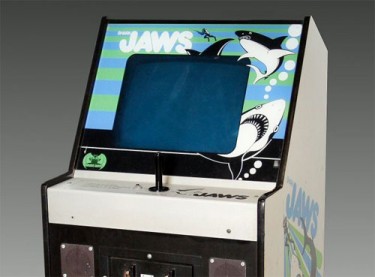
While it’s unclear exactly when most of these games hit the streets in 1975, a look at a 1982 issue of Video Games magazine gives us an exact date for the release of SHARK JAWS – September 25, just over three months after JAWS hit the screens. It’s a Corman (or Asylum)-level of cash-in speed, one that’s even more so impressive knowing that the game itself came from Atari, who set up an entirely new subdivision called “Horror Games” in order to distribute the game for fear of lawsuits by Universal.
The rumor is that Atari founder Nolan Bushnell had attempted to legally license JAWS from Universal, but the company was unreceptive, so he just went ahead and did it. “Atari had a real crude attitude about things,” he admitted in an interview. “JAWS was such a big movie and we decided we would do a game that was sharks eating people. We decided we would do it under the nom de plume of ‘Horror Games’.”
The disguise was, at best, minimal. The cabinets being used were just repurposed cabinets for TANK II, a 1974 game that served as part of their series of early arcade works that eventually inspired COMBAT. The circuit board was marked “Atari.” And just to provide the final clue for any copyright Sherlocks, the the distributor featured Atari’s logo, letting arcade owners know to “get all the details from your HORROR Games distributor or contact us at Atari, Inc.” If the company was set up to shield Atari from lawsuits, they sure did a terrible job at covering their tracks.
The game itself is fairly rudimentary: The player controls a spear fisherman who attempts to avoid an unnamed shark. One nifty feature is the sound, which includes emulating underwater noise by being filtered through a reverb pedal, and the scream when the player is killed.
Atari need not have worried about SHARK JAWS, as Universal either didn’t notice or didn’t care enough to bother pursuing legal action – something they wouldn’t necessarily keep doing in the future. The game reportedly sold a few thousand consoles (though this number is disputed, with the serial numbers not going over 500) and can still be found in the occasional classic arcade. It even managed to grace its way onto the silver screen, appearing as a gag in Joe Dante’s PIRANHA as well as SGT. PEPPER’S LONELY HEARTS CLUB BAND, though whether the latter is a wink to the rip-off nature of the film itself is anyone’s guess.
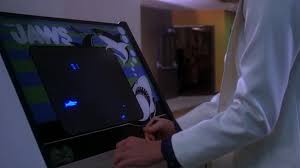
Download a MAME ROM for SHARK JAWS here!
MANEATER (PSE/Project Support Engineering, 1975)
MANEATER doesn’t have the most unique concept for the game itself. The player controls a diver who needs to collect gold from the bottom of the ocean and return it to the top of the screen. Two players could play at once. Outside of some relatively nifty animation for 1975, there’s not much to playing it.
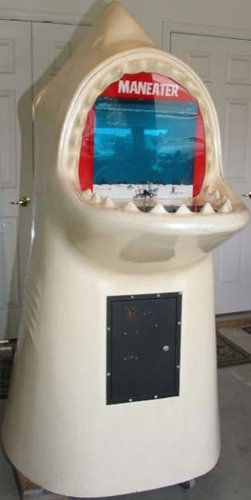
The cabinet itself, however, is another story. “Project Support Engineering,” which sounds more like a company that would ask you to check your firewall settings than to provide video game entertainment, went beyond the call of duty in making sure their game stood out on a crowded arcade floor by making the cabinet a shark itself, with the screen and controls nestled in the shark’s mouth. It’s a pretty damn great cabinet, probably among the top ten arcade video game cabinets ever designed.
The company also made a smaller, upright version, but MANEATER without the shark cabinet just wouldn’t be the same. (Sadly, as the game used integrated circuits rather than microprocessor ROMs, you can’t play it via an emulator. You’ll have to find the real thing. But now, don’t you want to?)
SHARK (U.S. Billiards, 1975)
All of this talk about playing human beings who are trying to avoid or shoot sharks has got to make you wonder – why do I have to play as some stupid person? These are JAWS rip-offs! Let me be a shark!

Enter SHARK, a blandly-titled entry from U.S. Billiards, a company located in, appropriately, Amityville, New York. In SHARK, you use four buttons to maneuver your (fairly crude) shark around a (fairly crude) maze in order to eat (fairly crude) swimmers. This is what a JAWS video game should be! You could even play with up to three of your friends.
Sadly, SHARK is pretty obscure – I wasn’t even able to dig up any example videos. Guess you’ll just have to keep watching those arcades!
BLUE SHARK (Midway, 1975)
It’s no MANEATER, but BLUE SHARK stands out amongst the first batch of Jaws-ploitation video games due to its look as well. First off, instead of a standard button controller, BLUE SHARK goes back to KILLER SHARK for inspiration, having the player control a spear gun that points at the screen and awards players points based on the creature hit – not only sharks but octopi and swordfish as well. Occasionally, another diver will appear in your way and you’ll lose points for shooting him.
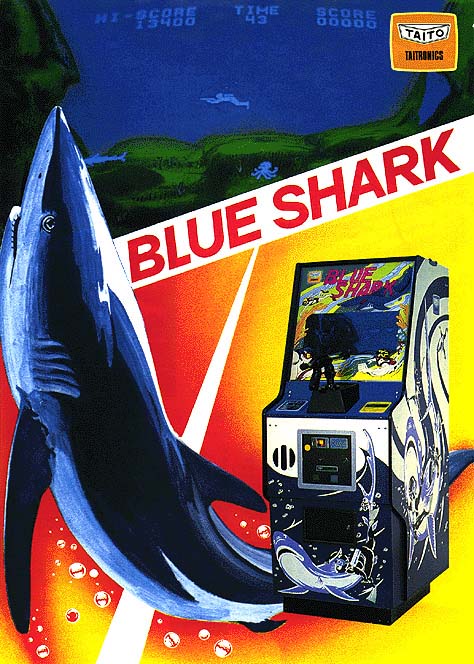
Like the other games of the year, the graphics are strictly white. However, BLUE SHARK utilizes a one-way mirror with the screen on the bottom and the mirror reflecting the game in front of a green underwater setting. (SPACE INVADERS, released in 1978 by Midway, would be a more well-known use the same technique.) It makes for an interesting aquarium effect, and one that brings a little bit more tone to the gameplay.
Download the MAME ROM for BLUE SHARK here!
SHARK TREASURE (Universal, 1978)
SHARK TREASURE, no relation (presumably) to the 1975 film SHARKS’ TREASURE with Yaphet Kotto, is made by Universal, no relation to the JAWS producer Universal Pictures. In it, the player controls a diver who must recover sunken treasure chests at the bottom of the sea while killing or avoiding hungry sharks. A treasure chest containing a moray eel must also be avoided. Every correct treasure chest must be taken to the ship after being recovered.
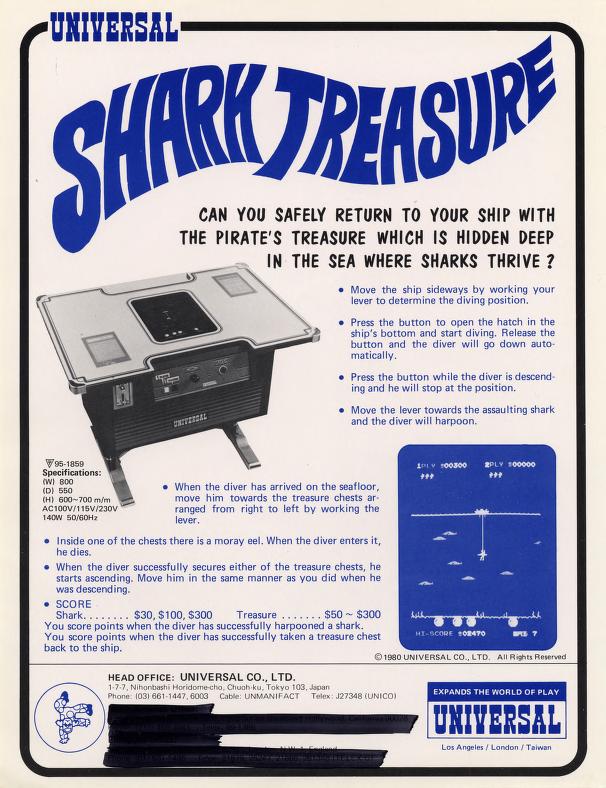
And that’s about all I can find on SHARK TREASURE, a barely-distributed cocktail game released about the time of JAWS 2 from a company that wouldn’t hit the big time until a few years later with MR.DO! and LADY BUG. A flier exists, but that’s about the extent of it. If anyone has any more info on SHARK TREASURE, I’d love to know it.
JAWS (Europlay, 1979)
In the wake of JAWS, there were a number of pinball games that tried to cash in on the shark craze (1976’s THE SHARK, 1979’s WHITE SHARK, 1980’s SHARK) but one sticks out enough to make this list for sheer audacity. It was actually called JAWS!
Now, don’t get your hopes up. There was technically no unique game called JAWS released – instead, Europlay released a conversion kit for Bally’s 1978 game PLAYBOY, adding a sound card and digital display to the mix, along with the reuse of some previously-used artwork from THE SHARK and 1970’s SCUBA.
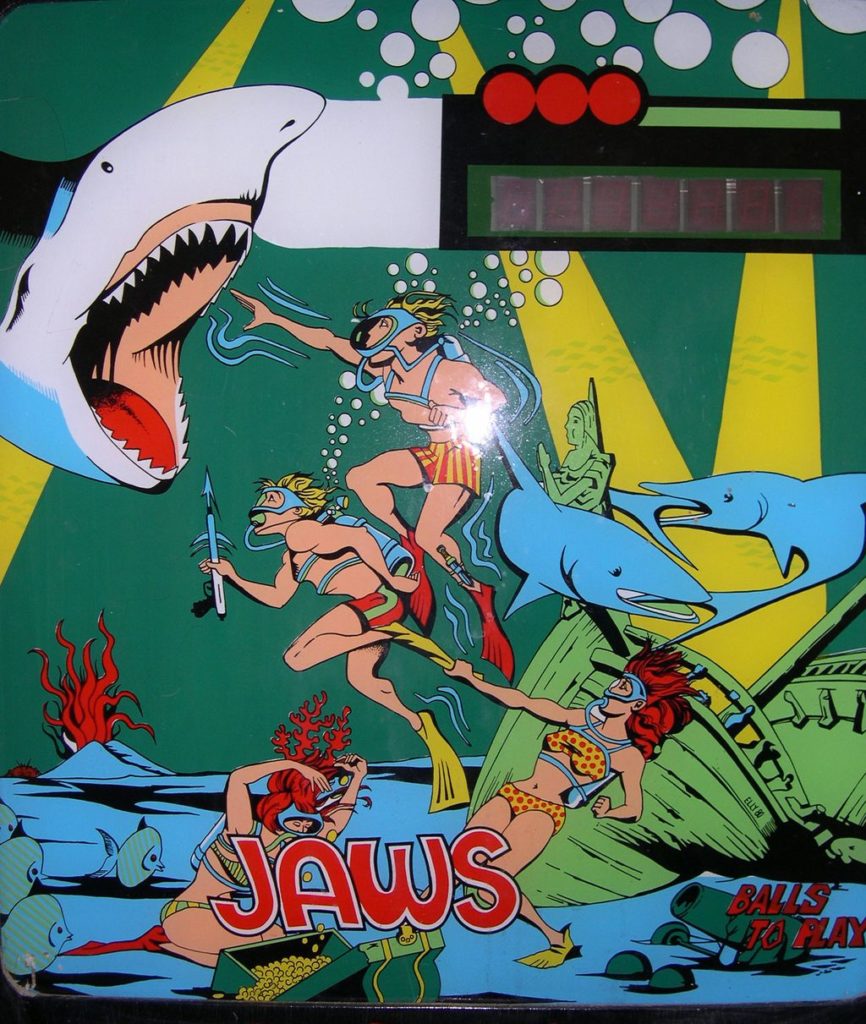
Not one but two pinball versions of JAWS finally surfaced last year – sort of. One was in the form of a VR pinball table from Universal Studios as an add-on to Pinball FX3, and the other a custom-made transition of a 1978 SINBAD machine. The former, however, isn’t quite “pinball” and the latter can only be played if you’re working for Discovery Channel, so it’s not quite the same.
DEEP DEATH/SHARK ATTACK (Pacific Novelty, 1980/1981)
“Just when you thought it was safe to go into the arcade,” the original promotional game flier read, copying the tag line from JAWS 2.
In 1980, Pacific Novelty released DEEP DEATH, an upright game where you got to be a great white shark who would attempt to eat scuba divers while avoiding their spears. Despite this great premise (and levels indicated by flashing skulls), the title and generic cabinet didn’t do much in the arcades, and the game is tough to find.
Fortunately for us, Pacific Novelty licensed the game to the Chicago-based Game Plan, who re-released it with the much better title SHARK ATTACK and a sexy campaign that promoted… er, the shark on a woman’s butt? Sure, whatever sells. Even better was the addition of quadraphonic sound and a cassette player inside the machine (with a looping cassette tape of actual “screams”) that would play every time you ate a diver.

Play SHARK ATTACK in your browser here!
LOCHJAW/SHARK ATTACK (Games By Apollo, 1982)
SHARK ATTACK wasn’t the only game to be renamed SHARK ATTACK. There was also SHARK ATTACK!
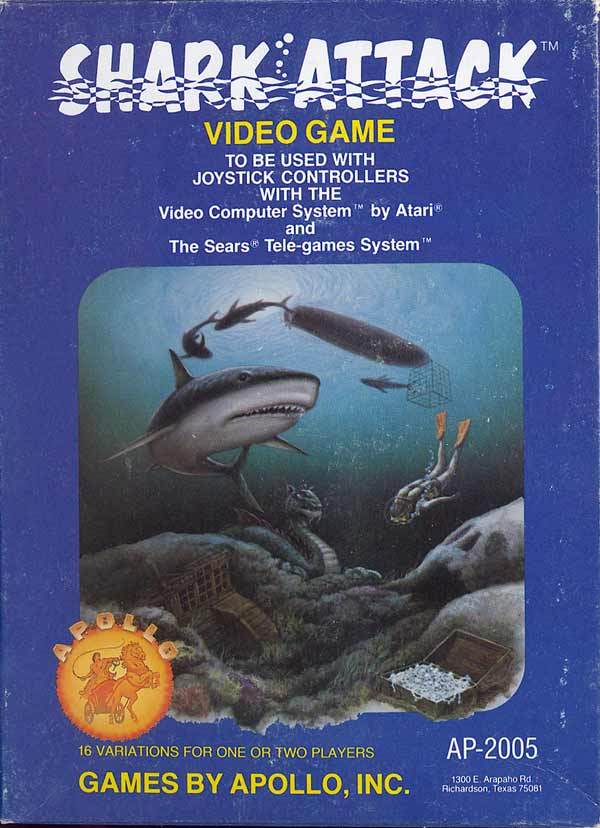
All of these games you can play in an arcade are great and all, but what about some shark action for our homebound gamers? Games by Apollo, one of the first third-party companies to produce cartridges for the Atari 2600 game system, knew they had a shark bite-sized niche to fill. Programmer Steve Stringfellow was assigned the task of producing LOCHJAW, which was basically a PAC-MAN rip-off, but with divers instead of Pac-Man, diamonds instead of dots, and sharks instead of ghosts. And the Loch Ness Monster shows up for some reason.
Heck, you can even get a glimpse of the Games by Apollo team talking about the game here!
One thing you’ll note in the interview above is that people talk about how great the title, LOCHJAW, is. It’s a shame, then, that it didn’t last – Universal, now actually pursuing such matters, threatened to sue Games by Apollo shortly after the game was released due to the name being too similar to JAWS. LOCHJAW was pulled, quick programming was done, labels were re-named, and SHARK ATTACK was born.
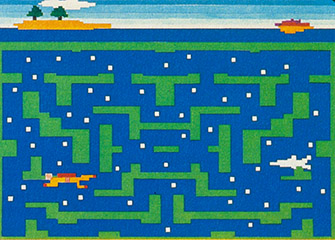
Of course, it’s a wonder Game Plan didn’t then sue them in order to avoid confusion with their own SHARK ATTACK. Maybe it was mercy – Games by Apollo was struggling, and ended up being one of the first casualties of the console crash when they went bankrupt in 1983.
Download an Atari 2600 ROM for SHARK ATTACK here!
SHARK! SHARK! (Intellivision, 1982)
The Atari 2600 may have been the big dog on the console scene, but it wasn’t the only one to benefit from Jaws-mania. Last, but certainly not least, in our deep-sea dive into the world of Jaws-ploitation is the Intellivision game SHARK! SHARK!, one of the most inventive games of the era in terms of mechanics.
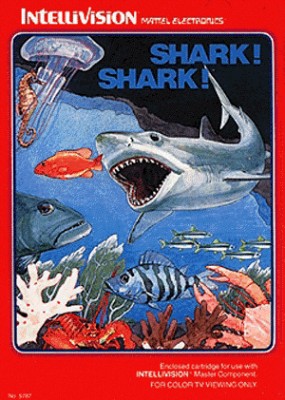
Despite the title, you play the role of a simple fish, though you are the predator, eating smaller fishes in order to gain points. What makes SHARK! SHARK! unique for the time is that the increase in food will actually increase your size, making it more unwieldy to move, similar to games like NIBBLER and a mechanic most memorably taken on by the KATAMARI series. It’s also notable as one of the few home video games of the era designed by a woman, Ji-Wen Tsao.
Mattel reportedly considered SHARK! SHARK! a kids’ game and didn’t have high hopes, but it received fantastic reviews and quickly sold out its first run. A version of the game was planned for the Aquarius home computer, but never materialized, though a prototype cartridge has been found. The game’s legacy continues today, with it appearing on Intellivision collections for the PlayStation 3, Xbox 360 and Windows, and it’s honestly just as addicting as it was 36 years ago.
Download the IntelliVision Lives! Pack including SHARK! SHARK! here!
The video game crash of 1983 meant the end for our finny friends in the land of joysticks, at least for a while. The Nintendo Entertainment System soon became commonplace in any kid’s household, and finally, in 1987, JAWS was properly licensed for a video game. It just… wasn’t all that great.
Two later entries, 1989’s JAWS: THE COMPUTER GAME and 2006’s JAWS UNLEASHED, were directly inspired by the original film but also failed to live up to their potential. (The latter was even given a “Worst Game Everyone Played” award from GameSpot and proved to be the final game of Appaloosa Interactive, who had much better luck underseas with their ECCO THE DOLPHIN series.)
Will there ever be a truly great JAWS video game? Or are game players simply doomed to hunt a great white shark of Bruce-inspired gameplay for all eternity, like Leela in the Futurama episode “Möbius Dick?” Only time, or potentially a reboot of the film series, will tell. In the meantime, check your local arcade – you never know when a shark is just around the corner! (It is behind Q*BERT.)
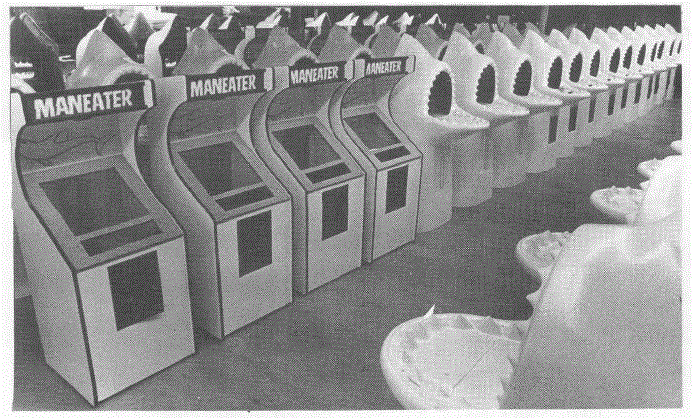
- JIM WYNORSKI RETURNS WITH THE CREATURE FEATURE ‘GILA’ - May 1, 2014
Tags: atari, Intellivision, Midway, Nintendo, Nolan Bushnell, roy scheider, Sega, Sharks, Steven Spielberg, Universal Pictures, Video Games

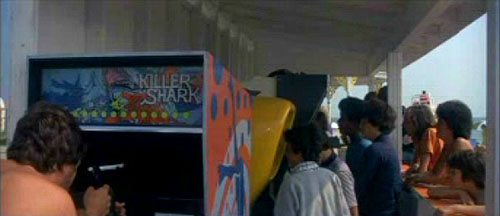

No Comments